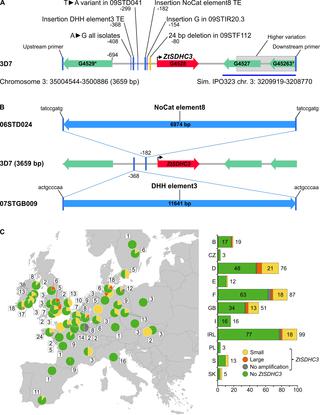当前位置:
X-MOL 学术
›
PLOS Pathog.
›
论文详情
Our official English website, www.x-mol.net, welcomes your
feedback! (Note: you will need to create a separate account there.)
A dispensable paralog of succinate dehydrogenase subunit C mediates standing resistance towards a subclass of SDHI fungicides in Zymoseptoria tritici.
PLoS Pathogens ( IF 5.5 ) Pub Date : 2019-12-20 , DOI: 10.1371/journal.ppat.1007780 Diana Steinhauer 1 , Marie Salat 1 , Regula Frey 1 , Andreas Mosbach 1 , Torsten Luksch 1 , Dirk Balmer 1 , Rasmus Hansen 2 , Stephanie Widdison 2 , Grace Logan 2 , Robert A Dietrich 3 , Gert H J Kema 4 , Stephane Bieri 1 , Helge Sierotzki 1 , Stefano F F Torriani 1 , Gabriel Scalliet 1
PLoS Pathogens ( IF 5.5 ) Pub Date : 2019-12-20 , DOI: 10.1371/journal.ppat.1007780 Diana Steinhauer 1 , Marie Salat 1 , Regula Frey 1 , Andreas Mosbach 1 , Torsten Luksch 1 , Dirk Balmer 1 , Rasmus Hansen 2 , Stephanie Widdison 2 , Grace Logan 2 , Robert A Dietrich 3 , Gert H J Kema 4 , Stephane Bieri 1 , Helge Sierotzki 1 , Stefano F F Torriani 1 , Gabriel Scalliet 1
Affiliation

|
Succinate dehydrogenase inhibitor (SDHI) fungicides are widely used for the control of a broad range of fungal diseases. This has been the most rapidly expanding fungicide group in terms of new molecules discovered and introduced for agricultural use over the past fifteen years. A particular pattern of differential sensitivity (resistance) to the stretched heterocycle amide SDHIs (SHA-SDHIs), a subclass of chemically-related SDHIs, was observed in naïve Zymoseptoria tritici populations not previously exposed to these chemicals. Subclass-specific resistance was confirmed at the enzyme level but did not correlate with the genotypes of the succinate dehydrogenase (SDH) encoding genes. Mapping and characterization of the molecular mechanisms responsible for standing SHA-SDHI resistance in natural field isolates identified a gene paralog of SDHC, termed ZtSDHC3, which encodes for an alternative C subunit of succinate dehydrogenase, named alt-SDHC. Using reverse genetics, we showed that alt-SDHC associates with the three other SDH subunits, leading to a fully functional enzyme and that a unique Qp-site residue within the alt-SDHC protein confers SHA-SDHI resistance. Enzymatic assays, computational modelling and docking simulations for the two SQR enzymes (altC-SQR, WT_SQR) enabled us to describe enzyme-inhibitor interactions at an atomistic level and to propose rational explanations for differential potency and resistance across SHA-SDHIs. European Z. tritici populations displayed a presence (20-30%) / absence polymorphism of ZtSDHC3, as well as differences in ZtSDHC3 expression levels and splicing efficiency. These polymorphisms have a strong impact on SHA-SDHI resistance phenotypes. Characterization of the ZtSDHC3 promoter in European Z. tritici populations suggests that transposon insertions are associated with the strongest resistance phenotypes. These results establish that a dispensable paralogous gene determines SHA-SDHIs fungicide resistance in natural populations of Z. tritici. This study paves the way to an increased awareness of the role of fungicidal target paralogs in resistance to fungicides and demonstrates the paramount importance of population genomics in fungicide discovery.
中文翻译:

琥珀酸脱氢酶C亚基的可分配旁系同源物介导了对小麦Zymoseptoria tritici中SDHI杀真菌剂亚类的持久抗性。
琥珀酸脱氢酶抑制剂(SDHI)杀真菌剂广泛用于控制各种真菌疾病。就过去十五年来发现和引入农业用途的新分子而言,这是增长最快的杀菌剂类别。在以前从未接触过这些化学物质的纯小麦结缕草种群中,观察到对延伸的杂环酰胺SDHIs(SHA-SDHIs)(化学相关SDHIs的一个子类)的不同敏感性(抗性)的特定模式。在酶水平上证实了亚类特异性抗性,但与琥珀酸脱氢酶(SDH)编码基因的基因型不相关。绘制和表征导致自然田间分离株对SHA-SDHI产生抗药性的分子机制,确定了SDHC的基因旁系同源物,称为ZtSDHC3,它编码琥珀酸脱氢酶的另一个C亚基,称为alt-SDHC。使用反向遗传学,我们显示了alt-SDHC与其他三个SDH亚基缔合,导致了功能齐全的酶,并且alt-SDHC蛋白中的独特Qp位残基赋予了SHA-SDHI抗性。两种SQR酶(altC-SQR,WT_SQR)的酶法测定,计算模型和对接模拟使我们能够在原子水平上描述酶与抑制剂的相互作用,并为跨SHA-SDHI的差异效价和耐药性提出合理的解释。欧洲的Z.tritici种群显示ZtSDHC3存在(20-30%)/不存在多态性,以及ZtSDHC3表达水平和剪接效率的差异。这些多态性对SHA-SDHI抗性表型有很大的影响。欧洲Z.Tritici种群中ZtSDHC3启动子的特征表明,转座子插入与最强的抗性表型有关。这些结果证明,可分配的旁系同源基因决定了天然小麦Z.SDHIs中对SHA-SDHIs的杀真菌剂抗性。这项研究为提高人们对杀真菌靶标旁系同源物在对杀真菌剂的抗性中的作用的认识铺平了道路,并证明了人口基因组学在杀真菌剂发现中的至为重要。
更新日期:2019-12-21
中文翻译:

琥珀酸脱氢酶C亚基的可分配旁系同源物介导了对小麦Zymoseptoria tritici中SDHI杀真菌剂亚类的持久抗性。
琥珀酸脱氢酶抑制剂(SDHI)杀真菌剂广泛用于控制各种真菌疾病。就过去十五年来发现和引入农业用途的新分子而言,这是增长最快的杀菌剂类别。在以前从未接触过这些化学物质的纯小麦结缕草种群中,观察到对延伸的杂环酰胺SDHIs(SHA-SDHIs)(化学相关SDHIs的一个子类)的不同敏感性(抗性)的特定模式。在酶水平上证实了亚类特异性抗性,但与琥珀酸脱氢酶(SDH)编码基因的基因型不相关。绘制和表征导致自然田间分离株对SHA-SDHI产生抗药性的分子机制,确定了SDHC的基因旁系同源物,称为ZtSDHC3,它编码琥珀酸脱氢酶的另一个C亚基,称为alt-SDHC。使用反向遗传学,我们显示了alt-SDHC与其他三个SDH亚基缔合,导致了功能齐全的酶,并且alt-SDHC蛋白中的独特Qp位残基赋予了SHA-SDHI抗性。两种SQR酶(altC-SQR,WT_SQR)的酶法测定,计算模型和对接模拟使我们能够在原子水平上描述酶与抑制剂的相互作用,并为跨SHA-SDHI的差异效价和耐药性提出合理的解释。欧洲的Z.tritici种群显示ZtSDHC3存在(20-30%)/不存在多态性,以及ZtSDHC3表达水平和剪接效率的差异。这些多态性对SHA-SDHI抗性表型有很大的影响。欧洲Z.Tritici种群中ZtSDHC3启动子的特征表明,转座子插入与最强的抗性表型有关。这些结果证明,可分配的旁系同源基因决定了天然小麦Z.SDHIs中对SHA-SDHIs的杀真菌剂抗性。这项研究为提高人们对杀真菌靶标旁系同源物在对杀真菌剂的抗性中的作用的认识铺平了道路,并证明了人口基因组学在杀真菌剂发现中的至为重要。











































 京公网安备 11010802027423号
京公网安备 11010802027423号